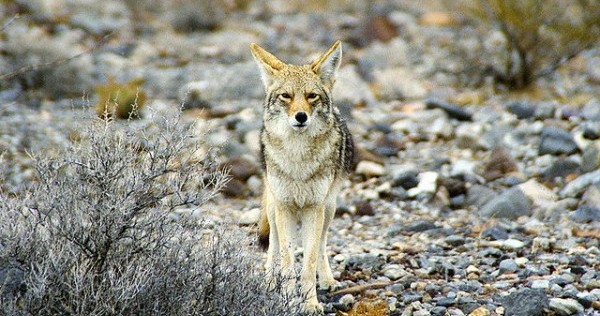
Coyote and Badger
They team up to hunt. The coyote (Canis latrans) has speed and a good nose. Coyotes can run 40 miles per hour. They feed on ground squirrels, marmots, and prairie dogs. The prairie dog escapes Mr. Coyote by vanishing into its burrow. Enter the badger (Taxidea Taxis). The badger is a digger. The badger digs down fast and deep. To escape the badger the prairie dog scampers out of its burrow and runs. He runs right into Mr. Coyote with his fast legs and sharp teeth. The badger and the coyote form an amicable alliance for hunting and they share their prairie dog dinner like two old codgers.
Canid and Hominid
Dogs (Canis lupus familiaris) follow their person’s (Homo sapiens) eyes to read this person’s mind. Dogs grovel, bow, beg, obey, disobey, slink, wag, cuddle, and lick, and they also sleep upon their human. Earl, my sister Liz’s rust-colored Australian shepherd, consumes entire pies—so far a cherry pie, a peach pie, and an apple pie. Besides purloining pies and pursuing squirrels, dogs act as sentinels, herders, guides, search partners, companions, alarm clocks. Dogs were the first domesticated animals. They evolved from wolves, likely “follower wolves” that followed prehistoric human camps. What do dogs get for their devoted cross-species alliance? Dog treat anyone? Pie?
Cow
The cow is a combination organism. Cows graze but cannot digest grass. It’s the microbes in their rumen (their first stomach) that digest the cellulose in grass. So firm is this cross-species alliance, so old, so indispensable to both organisms, that it’s more than an alliance. It’s a merger. There are thousands of species of rumen microbes—protozoa, bacteria. archaea, fungi. They feed on grass or they feed on the feeders-on-grass. They need the cow’s anaerobic (lacking oxygen) stomach. They need the cow to survive and the cow needs them to survive. As Betsey Dexter Dyer (A Field Guide to Bacteria) puts it, ruminants have vat-like physiques because in actual fact they are fermentation vats. After her microbes dine, the cow regurgitates the half-digested, now microbe-infested grass and chews it once again. Considering the contented look of cows chewing cud, cud chewing must be quite calming.
We Too Are Two
It’s like this. We are eukaryotes. Meaning that our cells have a nucleus contained by a membrane (the same as dogs, cows, prairie dogs, daisies, coyotes, etc.). Our DNA is coiled within this nucleus. Bacteria are prokaryotes—they have no such membrane-bound nucleus. Now, the part of our cells outside the nucleus, called the cytoplasm, is replete with mitochondria. These mitochondria, each contained by a double membrane, have their own DNA, different from the DNA in the nucleus of our cells.
The endosymbiosis theory holds that two billion years ago, a eukaryotic cell, which was then anaerobic (didn’t use oxygen), swallowed a bacterium for dinner. The bacterium failed to digest and instead began living within the protection of the eukaryote, feeding on snacks ingested by same. This bacterium earned its keep by oxidizing this food, creating energy more efficiently. Such bacteria evolved into our mitochondria.
This was biologist Lynn Margulis’s hypothesis, developed in the 1960s. It was greeted with hoots at first but has gradually been validated. For one thing, mitochondria have a double membrane (picture a gloved hand grabbing an apple). Genomics cinched it: the DNA in our mitochondria is closer to that of several kinds of bacteria than it is to the DNA in the nucleus of our cells.
This momentous biological event occurred long before our time, but one result was us. We too are combination organisms.

